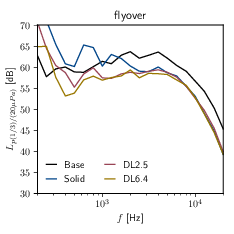ENGINEERING AND CFD
Mitigation of Landing Gear Noise using Porous Fairings
Principal Investigator:
Dr. Matthias Meinke
Affiliation:
RWTH Aachen, Aerodynamisches Institut, Aachen, Germany
Local Project ID:
GCS-MINION
HPC Platform used:
JEWELS Booster of JSC
Date published:
Abstract
The noise mitigation effect of upstream installed fairings on a simplified two-wheel nose landing gear at a freestream Mach number of M∞ = 0.1 and a wheel based Reynolds number of ReD≈ 350, 000 is investigated. Three different configurations, i.e., a baseline, a baseline with a solid fairing, and a baseline with a porous faring, are analyzed. The turbulent flow and acoustic near fields are directly predicted by a lattice Boltzmann (LB) method. To avoid unfeasible number of grid points the flow inside of the porous material is modeled by a Forchheimer-extended Darcy model relating the drag of the material on the flow to the bulk velocity. The simulations are in well agreement with experimental results showing beneficial noise mitigation of the applied fairings.
Motivation
The mitigation of aircraft noise is a major goal of the society to reduce the harmful effects on the human health and cognitive performance when exposed to a pervasive noise level. Although several events in the past have temporarily reduced the air traffic, a long-term constant growing rate if 4- 8%p.a. of passengers has been observed in the recent years. New concepts for on-demand Urban Air Mobility evolve and thus, additionally implying an extension of urban areas. Coping with this trend, the ACARE1 defined ambitious goals of Europe’s vision for aviation for the year 2050 in the Flightpath 2050. It aspires, inter alia, a reduction of perceived aircraft noise by 65% relative to the capabilities of a typical aircraft in the year 2000.
Aircraft noise becomes relevant during phases at low altitude, i.e., take-off, approach, and landing. It mainly originates from i) engines noise generated by the fan and the hot jet, and ii) airframe noise arising from high lift devices (HLD) and landing gears (LG). During approach and landing the engines are operated almost under idle conditions. Hence, noise arising from HLD and LG become the dominant contributor.
While the HLD have been studied intensively, systematic studies of LG noise and its mitigation are still required.
Numerical Approach
All simulations are performed with the solver framework m-AIAdeveloped at the institute of aero- dynamics at RWTH Aachen University and validated against experimental measurements [1] The turbulent flow and acoustic near field are predicted by large eddy simulations (LES) solving for the lattice Boltzmann (LB) equation. Due to the disparity of length scales in the turbulent external flow around the LG and those defined by the porous micro-structures, it is computationally infeasible to resolve all scales simultaneously. Therefore, a volume-averaging approach is established, such that the effect of the porous material on the flow field, i.e., its drag force, is modeled in relation to the present bulk velocity through the material [2].
Even though the LB method is capable of simultaneously solving for the flow and acoustic field, a prediction of sound pressure levels radiated into the far field is computationally too expensive. Hence, the propagation from the near to the far field is simulated by solving the Ffowcs Williams and Hawkings (FWH) equation [3].
The LB solver has been ported to be performed on GPU devices to run on JUWELS Booster Module using C++ standard 17 parallel algorithms implemented in the NVIDIA HPC SDK allowing for a hardware-agnostic implementation.
Figure 1: Instantaneous velocity magnitude field on isovolumes of Q-criterion for the baseline (left) and baseline with solid fairing (right) configurations.
Figure 2: Root mean square of the fluctuating wall pressure in dB (pref = 20 µPa). For a better visualization the left wheel is shifted downwards.

Figure 3: Sound pressure level filtered in one-third octave bands at a flyover microphone position for the different landing gear configuration.
Results
In fig. 1 the effect of an installed solid fairing on the flow field is visualized. While vortices shedding from the torque link (TL) and brakes are mitigated by the lateral flow deflection of the fairing, additional separations on the edge of the fairing as well as an amplification of the lateral wheel separation is present. This deflection significantly reduces fluctuating part of the surface pressure, see fig. 2. These surface pressure fluctuation are a well-known indicator of noise generation. Here, the fairings mitigate these between the wheels and in front of the strut. Additional noise arise on the strut where the separation of the fairings hits on the strut. The influence on the far field noise is given by noise spectra in fig. 3 for an observer point located nine wheel diameter in fly over position. All fairings reduce the broad band sound pressure level from mid to a high frequencies. For lower frequencies the solid fairing produces additional noise. This adverse contribution is lowered by the porous fairings with decreasing resistivity preserving the favorable high frequency noise reduction. The presented results are in well agreement with experimental measurements obtained at Delft Universityof Technology.
References
[1] M. Gondrum, A. Niemöller, M. Meinke, W. Schröder, A.R. Carpio, D. Ragni, and F. Avallone. Landing Gear Noise Mitigation by an upstream installed Fairing. In 28th AIAA/CEAS Aeroacoustics Conference. American Institute of Aeronautics and Astronautics, 2022.
[2] M. Gondrum, M. Meinke, W. Schroeder, F. Avallone, and D. Ragni. Porous fairings for landing gear noise mitigation. In 30th AIAA/CEAS Aeroacoustics Conference. American Institute of Aeronautics and Astronautics, 2024.
[3] J. E. Ffowcs Williams and D. L. Hawkings. Sound generation by turbulence and surfaces in arbitrary motion. Phil. Trans. R. Soc. London A, pages 321–342, 1969.
Contact
Project contributor, Research Scientist, m.gondrum@aia.rwth-aachen.de.
Prinicpal investigator, Senior Scientist, m.meinke@aia.rwth-aachen.de.
1Advisory Council for Aviation Research and innovation in Europe